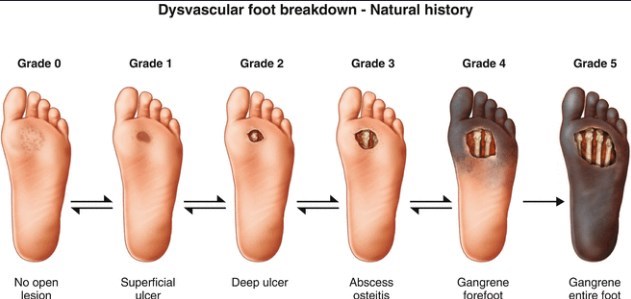Diabetic foot ulcer 1.7 times more likely if poor Vitamin D Receptor
Vitamin D receptor gene FokI variant in diabetic foot ulcer and its relation with oxidative stress
Gene, Vol599, 30 Jan 2017, Pages 87–91 http://dx.doi.org/10.1016/j.gene.2016.11.012
Negin Sorousha, Mania Radfara, b, , radfarma@tums.ac.ir, Armita Kakavand Hamidic, Mohammad Abdollahid, Mostafa Qorbanie, Farideh Razif, Ensieh Nasli Esfahanif, Mahsa M Amolic, ,

Publisher wants $36 for the PDF
Highlights
Association of VDR rs2228570 T allele with DFU in Iranian patients with T2DM is found
T allele is more frequent in patients with severe DFU based on Wagner classification
Hyperglycemia causes generation of free radicals which leads to oxidative stress (OS)
FokI variant correlation with TBARS level was found in patients carrying T allele
Purpose
The patient's suffering and financial costs affiliated with Diabetic Foot Ulcer (DFU), as one of the most important complications of diabetes, are highly undesirable and this highlights the importance of preventive medicine about this disorder. Furthermore hyperglycemia causes generation of free radicals which leads to oxidative stress (OS). Hence, this study aims to examine the association between vitamin D receptor (VDR) gene FokI polymorphism and DFU in Iranian population and also its correlation with OS biomarkers.
Materials and methods
In a case-control study, a total of 212 patients with type 2 diabetes with and without diabetic foot ulcer were included. Genotyping was conducted by polymerase chain reaction and restriction fragment length polymorphism (PCR-RFLP) analysis. Samples were analyzed for thiobarbituric reactive substances (TBARS) and ferric reducing ability of plasma (FRAP) as markers of OS.
Results
The results indicated a significant difference in genotype frequencies of VDR gene FokI polymorphism in patients with diabetic foot ulcer in comparison to those without diabetic foot ulcer (TT + TC vs. CC p = 0.04; OR = 1.76 ; 95% CI = 1.02–3.05). Moreover, the patients carrying the T allele had a significantly higher level of TBARS (p = 0.01).
Conclusions
We found a significant association between FokI functional variant of VDR gene and diabetic foot ulcer in an Iranian population. Increased levels of TBARS in patients carrying the T allele of FokI polymorphism indicate an association between this variant and OS in patients with diabetes.
